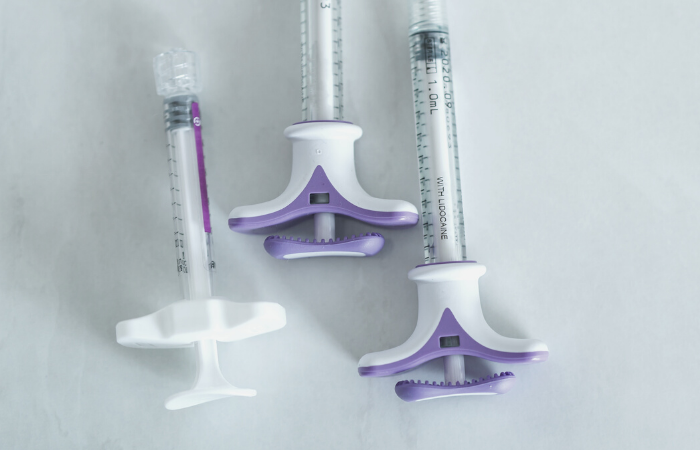
Nowadays, injectable dermal fillers are increasingly being defined as either Monophasic or Biphasic. Contrary to popular belief, these are terms that relate to their structural properties, as opposed to their viscosity or ‘G prime’.
On the surface of things, both types have more similarities than differences. Fundamentally, Monophasic and Biphasic fillers are made up of cross-linked hyaluronic acid (HA) molecule chains. They provide a stable and predictable result when used for facial augmentation, which cannot be achieved by highly-spreadable, non-crosslinked HA molecules (although this type of hyaluronic acid is a popular ingredient in many mesotherapy products).
Monophasic and Biphasic products are typically used to smooth out wrinkles and folds, as well as to volumise key areas (lips, cheeks, tear troughs and jawline, to name a few). Most modern Monophasic and Biphasic fillers contain a small amount of local anaesthetic, in order to make treatments more comfortable. Both types will also gradually break down over the course of a few months, requiring repeat treatments to maintain their effects.
So the question still remains – is there a significant degree of difference between them? Here’s everything you need to know!
As implied by the term itself, ‘Monophasic’ means one phase. A single syringe of Monophasic filler contains just one ‘phase’ or type of hyaluronic acid gel. Monophasic products have been extensively studied and their safety has been well-documented in clinical trials; for that reason, many injectors consider them to be first-line choices when selecting their preferred dermal filler product.
Biphasic hyaluronic acid fillers are so-called as they’re effectively ‘two-part’. The concept is pretty straightforward: they consist of cross-linked HA chains as Monophasic fillers do, but incorporate free HA molecules alongside them. The ‘two phases’ of a Biphasic filler product, therefore, refer to these two different types of hyaluronic acid contained in a single syringe.
Although popular in Europe and Korea, Biphasic formulations are relatively new entrants into the US market.
During the injection process, Biphasic fillers behave almost identically to Monophasic fillers. However, the blend of different HA molecules in Biphasic fillers makes for a lower extrusion force and an easier injection process for the practitioner.
There’s some debate regarding which type is best for use in certain facial areas or for specific indications, however. It has been said that Biphasic fillers provide a greater degree of volumisation and have additional rejuvenating properties on account of their free hyaluronic acid molecules. This may make them a top choice among injectors who treat larger areas that require both projection and improvement of the overlying skin, such as that across the cheeks.
More debate surrounds these products’ cohesiveness and their potential to retain water. Although Monophasic fillers are said to be more cohesive with a marginally lower chance of migration in comparison to Biphasic fillers, it’s pretty much an accepted fact that they retain more water, meaning that immediate post-treatment downtime can be more protracted and results may even look ‘overdone’ if not injected conservatively. Some injectors, therefore, prefer them for the treatment of small and highly mobile areas.
Individuals with relatively minor facial folds or who desire a more natural look may be more suitable for treatment with a Biphasic filler. However, this is generally not the right choice for creating a sharp or defined look, which is better provided by a Monophasic product.
The general consensus, however, is that using a Monophasic or Biphasic filler product with local anaesthesia makes for a more comfortable procedure and allows normal activities to be resumed sooner. Despite this, products without local anaesthetic do exist in both categories; these can be used either with numbing cream alone, or combined with local anaesthesia using a syringe connector.
With so many options on the market today, it can be difficult to decipher which one works better than another. Moreover, as more advanced dermal filler products enter the global market, the distinction between Monophasic and Biphasic products is becoming more blurred.
For example, VOM dermal fillers use multi-layered technology to create a Biphasic dermal filler range that combines this formula with additional Monophasic particles. Similarly, KFDA-approved Wellsfill dermal fillers contain a mixture of Monophasic and Biphasic HA molecules.
Recent efforts to produce reinforced versions of both of these dermal filler types reflects the growing demand for hybrid fillers; a new generation of dermal filler products that are versatile, can be used in multiple areas of the face, have more stability and promote longevity, durability and better results.
Some may argue that the distinctions between Monophasic and Biphasic fillers are irrelevant – both due to more modern methods of manufacture that may be considered more integral in the creation of a quality end product, as well as other factors that may have a greater degree of influence on treatment results.
Beads Max is a Monophasic product, yet its 3-stage microbead technology aims to overcome the common problem of the difficult injection of Monophasic products. This makes for a dermal filler range with an easier degree of syringeability than what was previously available for use. Furthermore, the Celosome Monophasic range utilises an 8-stage manufacturing process and specialised crosslinking technology for a safer, purer formulation that aims to minimise the risk of any reaction occurring post-treatment.
Monophasic fillers are more widely available than Biphasic fillers and they continue to be a popular choice for facial rejuvenation, although – as the market continues to grow – more sophisticated dermal fillers are being produced. On average, at least one to two treatment sessions will be required to produce noticeable improvements from either type.
There’s no doubt that these choices come down to personal preferences, usually informed by direct experience. But if you’re looking for a dermal filler that gives a natural result, is relatively easy to inject, results in little downtime and has little chance of negative side effects, then a newer generation dermal filler product might be a great starting point for you.

Cookies are used to access and store information on your device, to offer personalised content based on your data. By choosing “I agree” you consent to our use of cookies.
*Discount applies to first orders; shipping excluded.